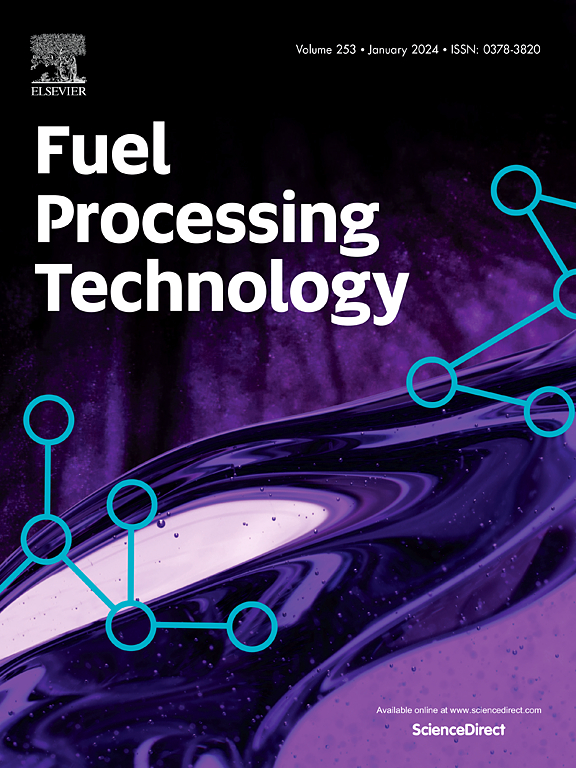Inhibiting metal phase separation of redox catalysts by balancing reduction - oxidation step in chemical looping dry reforming of methane
IF 7.2
2区 工程技术
Q1 CHEMISTRY, APPLIED
引用次数: 0
Abstract
The suppression of metal phase separation in multimetallic redox catalysts during the oxidation-reduction process of chemical looping for efficient hydrocarbon activation continues to pose a significant challenge. In this study, we have uncovered that the modestly oxidizing CO2 can facilitate in-situ oxygen replenishment, concurrently occupying the oxygen vacancies generated during the reduction of lattice oxygen in the LaFeO3 redox catalyst by strongly reducing agent CH4. This mechanism not only gives rise to the production of syngas but also promotes the self-regeneration of the redox catalyst, effectively inhibiting the segregation of metallic phases. Thermodynamic analysis and experimental evidence suggest that the oxidized and reduced states of LaFeO3 redox catalyst can achieve partial oxidation of CH4 and reduction of CO2 concurrently, with the addition of CO2 promoting the recovery of the crystal phase structure and lattice oxygen of LaFeO3. As a result, the developed redox catalyst demonstrates remarkable stability, undergoing 30 h of continuous operation with nearly no deactivation observed. Critically, the 18O isotope tracer reveals the migration pathway between surface lattice oxygen and gaseous oxygen. Mechanistic studies indicate that the surface lattice oxygen of the redox catalyst effectively promotes rapid partial oxidation of CH4, generating surface oxygen vacancies that are then in situ regenerated after being filled by CO2. This finding underscores the significance of weakly oxidative atmospheres, such as CO2, in maintaining the stability of the chemical looping process.
化学环法甲烷干重整中平衡还原-氧化步骤抑制氧化还原催化剂金属相分离
在化学环氧化还原过程中,抑制多金属氧化还原催化剂中金属相分离以实现高效的碳氢化合物活化仍然是一个重大挑战。在本研究中,我们发现适度氧化的CO2可以促进原位氧补充,同时占据强还原剂CH4还原LaFeO3氧化还原催化剂中晶格氧产生的氧空位。该机制不仅产生合成气,而且促进了氧化还原催化剂的自再生,有效地抑制了金属相的偏析。热力学分析和实验证据表明,氧化还原态的LaFeO3氧化还原催化剂可以同时实现CH4的部分氧化和CO2的还原,CO2的加入促进了LaFeO3的晶相结构和晶格氧的恢复。因此,所开发的氧化还原催化剂表现出显著的稳定性,经过30小时的连续操作,几乎没有观察到失活。关键的是,18O同位素示踪剂揭示了表面晶格氧和气态氧之间的迁移途径。机理研究表明,氧化还原催化剂的表面晶格氧有效地促进CH4的快速部分氧化,产生表面氧空位,然后被CO2填充后原位再生。这一发现强调了弱氧化气氛(如CO2)在维持化学环过程稳定性方面的重要性。
本文章由计算机程序翻译,如有差异,请以英文原文为准。
求助全文
约1分钟内获得全文
求助全文
来源期刊

Fuel Processing Technology
工程技术-工程:化工
CiteScore
13.20
自引率
9.30%
发文量
398
审稿时长
26 days
期刊介绍:
Fuel Processing Technology (FPT) deals with the scientific and technological aspects of converting fossil and renewable resources to clean fuels, value-added chemicals, fuel-related advanced carbon materials and by-products. In addition to the traditional non-nuclear fossil fuels, biomass and wastes, papers on the integration of renewables such as solar and wind energy and energy storage into the fuel processing processes, as well as papers on the production and conversion of non-carbon-containing fuels such as hydrogen and ammonia, are also welcome. While chemical conversion is emphasized, papers on advanced physical conversion processes are also considered for publication in FPT. Papers on the fundamental aspects of fuel structure and properties will also be considered.
 求助内容:
求助内容: 应助结果提醒方式:
应助结果提醒方式:


